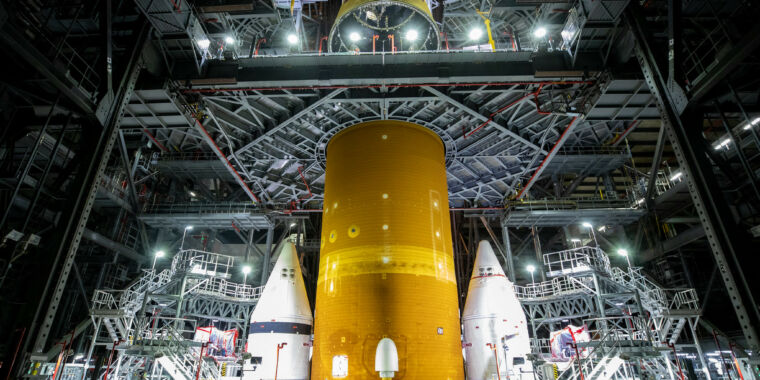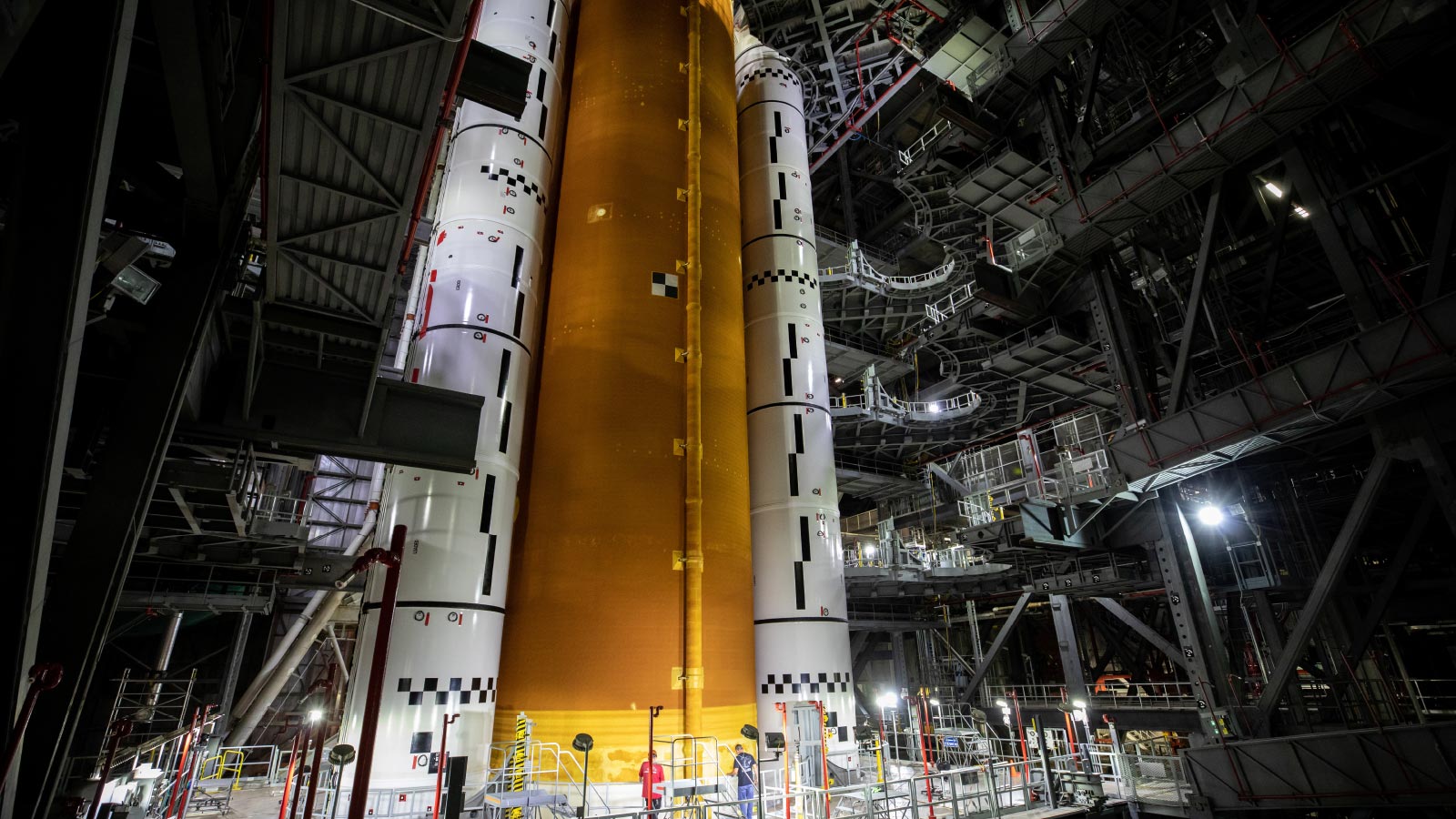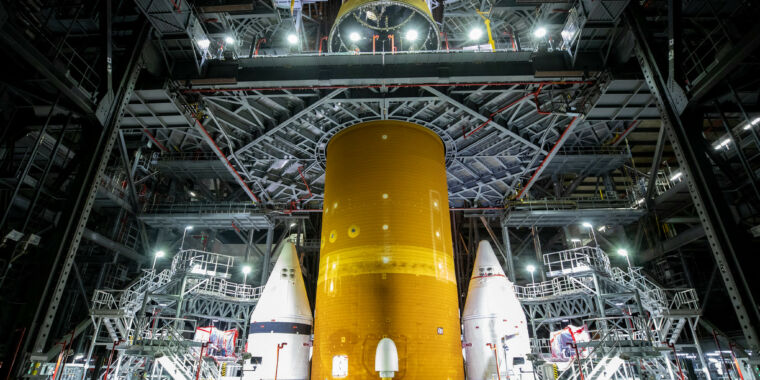
Space Launch System – The Recycled Rocket
It takes an extremely powerful rocket in order to reach the Moon. This especially is the case when planning to bring a large number of humans and cargo there as well. Over time NASA has been working on the Space Launch System which is meant to be the next best thing. Unfortunately, the launch vehicle is turning out to be a very expensive, and delayed rocket with major components taken from past rockets such as the Space Shuttle.
Some of the main parts of the Space Launch System are simply reused from the Space Shuttle. NASA claims each of these parts has been upgraded but the result is still very similar. NASA is confident this helps reduce the cost and eliminate risk with hardware-tested components. However, SLS is set to be one of the most expensive launch vehicles NASA has ever created with an even more expensive future ahead of it.
The Space Launch System is a vital piece to many of the future Artemis missions. With 6 different planned variants for the Moon alone, NASA is confident in this rocket. With this, they have spent years developing, manufacturing, and preparing SLS for the upcoming first launch attempt. Here I will go more in-depth into some of the downsides of SLS and specifically some of the main components that have been reused from the Shuttle.
Reused Components

I first want to focus on some of the main aspects of SLS that NASA is working to upgrade and reuse. The agency mentions in regards to SLS that, “NASA is upgrading proven hardware from the space shuttle and other exploration programs while making use of cutting-edge tooling and manufacturing technology. Some parts of the rocket are new and other parts have been upgraded with modern features that meet the needs of deep space missions, which require higher launch vehicle performance levels.” The first main component being reused are the engines. Propulsion for the SLS core stage will be provided by four RS-25 engines. These are the same engines used years ago on the Space Shuttle and are now planned to provide 2 million pounds of thrust for the SLS. Specifically, “Aerojet Rocketdyne of Sacramento, California, is upgrading an inventory of 16 RS-25 shuttle engines to SLS performance requirements, including a new engine controller, nozzle insulation, and required operation at 512,000 pounds of thrust.” NASA has access to quite a few of these older engines which they are now slightly upgrading for the main engines of the Space Launch System. Looking at the difference between thrust for the engine before and after upgrades, it is not very significant. When used on the Shuttle the RS-25 engine produced 492,000 pounds of thrust in a vacuum. Now in 2022 after some slight upgrades, they produce 512,000 pounds of thrust.
Next, we have the solid rocket boosters or SRBs. These are the large white boosters placed on either side of the launch vehicle. These two boosters alone provide more than 75 percent of the vehicle’s thrust during the first two minutes of flight. NASA points out that, “The prime contractor for the boosters, Northrop Grumman’s Northern Utah team, has modified the original shuttle’s configuration of four propellant segments to a five-segment version. The design also includes new avionics, propellant grain design, and case insulation, and eliminates the recovery parachutes.” These same boosters are being worked on for future Artemis missions including two. Specifically, Northrop Grumman has completed motor segments for Artemis II and is working on boosters for missions beyond Artemis II. Trains transport booster segments from Utah to NASA’s Kennedy Space Center in Florida where they are stacked with forward and aft assemblies. For the most part, when comparing these large solid rocket boosters to each other there are only small differences you can make out. In terms of the thrust upgrades, similar to the engines it is not very large. Original SRBs on the Shuttle produced around 3.3 million pounds of thrust each while the new and improved are said to produce close to 3.6 million pounds of thrust per.
Cost & Future Plan

The major benefits of reusing these old components on a new rocket is meant to be money and time. Yet throughout SLS development, it seems the launch vehicle is only getting more expensive and experiencing more delays. It is estimated development costs of this launch vehicle are in the high billions with an expected cost per launch of around $2 billion. This would make the Space Launch System an unbelievably expensive rocket not only to create but continue to launch in the future. In terms of development time, SLS has been in the works for a very long time with many delays throughout the process. As we get closer to the initial estimated crew launch in 2024, it looks less likely to happen. While the Space Launch System and Space Shuttle are very different in many ways, they are also similar in some. Key components like the engines and solid rocket boosters are the same with the exception of a few upgrades. The Space Shuttle had a cost per launch of around $450 million. While still high it makes the $2 billion SLS cost look even worse.
A big part of a majority of the future Artemis missions revolves around the Space Launch System. Not to mention NASA sees this rocket as an option to continue to use and upgrade in the future. Specifically, the agency mentions, “The SLS rocket is designed to be evolvable, which makes it possible to fly more types of missions, including human missions to the Moon and Mars and robotic scientific missions to places like the Moon, Mars, Saturn, and Jupiter.” Based on NASA’s plans we are likely to see the use of this launch vehicle for a very long time. For Artemis alone, the agency already has 6 different variants each serving a specific purpose. This includes mainly different power and payload capabilities to help deliver cargo and humans to the Moon. The Space Launch System is meant to be the next-generation launch vehicle that will help facilitate incredible things related to space. While I hope and think this will partially be the case, no matter what it does it will cost a significant amount of money despite the reuse of different main components and more. Ideally, as the Space Launch System evolves over time it will become a more efficient and cheaper launch vehicle. Unfortunately for the time being that is not exactly the case. Either way, SLS has a very important job in the near future that could help bring humans back to the surface of the Moon.
Conclusion
In order to not only get to the Moon but have a large payload brought with you, an extremely powerful rocket is necessary. Over the past few years, NASA has worked to develop and manufacture the Space Launch System. This is meant to be the next best thing capable of future missions to the Moon, Mars, and beyond. Looking at some of the main components of this rocket such as the engines or the solid rocket booster you will see the same models from the Space Shuttle. As time goes on we can hope for the success of the Space Launch System and see how it affects the space industry.
